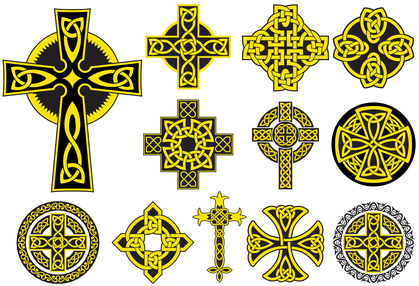The history of the Celts goes back thousands of years. The Celtic people were recognized far and wide for their first-class skills in jewelry, artwork, arms, and even metalworking. Regarded as ferocious battlers by the Romans, they were warriors from top to bottom. Throughout Ireland and the coastline of England, you can see top-notch examples of Celtic artwork and Celtic crosses.
Over time, modern Celtics developed and established symbols for themselves along the way. Celtic people in Northern America are known to display Celtic symbols to allow others to know that they have Celtic descent. Celtic symbols and knowledge have been passed down through the ages as there is little recognized written history retained today. Tattooing, however, keeps Celtic traditions alive with the notorious Celtic cross and other common Celtic designs.
The bulk of Celtic tattoo designs and artwork come from Ireland where the history of the Celts is still very strong to this day. In Trinity College Dublin, Ireland you can see lots of documentation in manuscripts on Celtic symbols and heritage. Celtic tattooing reached its peak at about the same time that metalwork and stonework became highly desired.
Celtic knot tattoos are amongst some of the most favorite and most common designs, sporting loops with no end that symbolize a ne’er ending cycle of death and rebirth. There are also Celtic animal tattoo designs as well, which are similar in design to the knot tattoos, although the cords in the design commonly terminate in feet, tails, or heads. Unless the person having the tattoo requests an end to the Celtic design to make a spiral then the Celtic knot tattoo design is usually ne’er ending.
The proper meaning of the intricate knots found in Celtic tattoos resists all types of literal translation and its significance is found at a far deeper level. The complexity of the knots shows the persistent crossing of both physical and spiritual elements. The strands and their ne’er ending path are a favorite design for Celtic tattoos, symbolizing life, faith, and love. Used for heritage as well as emotional purposes the Celtic people have used these tattoos for many years.
People who come from a Celtic lineage, Scots, Irish, or Welsh, commonly find a Celtic tattoo to be a good way to express their heritage pride. As well as giving tribute to their roots these tattoos help to reestablish pride in their long history. The tattoos aren’t simple to do, most taking several hours. Unlike other tattoo designs, Celtic tattoos are amongst the toughest designs in the world.
If you come from a Celtic ancestry and have decided to get a Celtic tattoo, the first thing to do is find an artist capable of doing the tattoo. These designs are very challenging and not all tattoo artists can carry them out. It’s a good idea to find a tattoo artist who has a history in Celtic designs, as this will ensure the tattoo is made right. The artist who makes the tattoo needs to have an eye for detail and perfect line placement which is a skill that not all tattoo artists possess.
Author: Forbes Jarvis
To find out more about Celtic tattoos, visit Celtic Tattoo Designs.







I am looking for a Celtic luck knot for a tattoo
Do you have any images of Celtic luck knots you can send me for tattooing purposes?
I would like to know what he of those symbols above actually stand for, do you know the meanings???
I’m looking for a cool Celtic cross tattoo for my upper back between my shoulder blades. Something that states ” strength” bravery.
Thank you for any help
[…] It is a known fact that Celtic tattoos are quite popular among today’s youngsters. The Celtic tattoo has the great power to reveal your intimate self thanks to the symbolism coming from an ancient […]